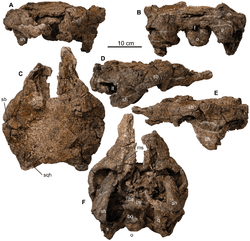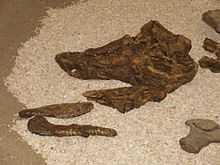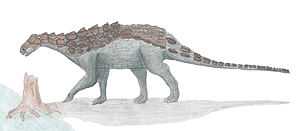Europelta
| Europelta Temporal range: Early Cretaceous, 112Ma | |
|---|---|
 | |
| Skull of the holotype specimen | |
| Scientific classification | |
| Kingdom: | Animalia |
| Phylum: | Chordata |
| Clade: | Dinosauria |
| Order: | †Ornithischia |
| Family: | †Nodosauridae |
| Subfamily: | †Struthiosaurinae |
| Genus: | †Europelta Kirkland et al., 2013 |
| Type species | |
| †Europelta carbonensis Kirkland et al., 2013 | |
Europelta is an extinct genus of struthiosaurine nodosaurid dinosaur known from the Early Cretaceous (early Albian stage) lower Escucha Formation of Teruel Province, northeastern Spain. It contains a single species, Europelta carbonensis. It is known from two associated partial skeletons, and represents the most complete ankylosaur known from Europe.[1]
Discovery

Europelta was first described and named by James I. Kirkland, Luis Alcalá, Mark A. Loewen, Eduardo Espílez, Luis Mampel and Jelle P. Wiersma in 2013 and the type species is Europelta carbonensis. The generic name combines a contraction for Europe, as it is the most complete ankylosaur from the continent, and πέλτα (pelta) Ancient Greek for "shield", a common suffix for ankylosaurian genus names in reference to their armored bodies. The specific name means "from the coal", from the Latin carbo, in honor of the access provided by the Sociedad Anónima Minera Catalano-Aragonesa (SAMCA Group) to the fossil locality where Europelta was found, in the open-pit Santa María coal mine.[1]
Europelta is known from two associated partial skeletons, reposited at Fundación Conjunto Paleontológico de Teruel-Dinópolis/Museo Aragonés de Paleontología (FCPTD/MAP). Discovered in 2011, the remains came from Fundación Conjunto Paleontológico of Teruel-Dinópolis locality AR-1, located east of Ariño, in the northern Teruel Province in the Community of Aragón. This vertebrate site occurs below the lowest mineable coal seam operated by SAMCA Group's Ariño coal mine in a plant debris bed in the lower Escucha Formation, and the most abundant dinosaur identified from it is the iguanodontian Proa valdearinnoensis. The paratype of Europelta was collected 200 meters laterally from the holotype in the same bed. The site dates to the early Albian stage of the late Early Cretaceous, based on an analysis of the palynomorphs, ostracods and charophytes (nanofossils).[1]

The holotype, AR-1/10, represents a disarticulated partial skeleton spread over an area of seven by three meters. It consists of a nearly complete skull, isolated left and right nasals, a dentary fragment, 15 isolated teeth, an atlas, five cervical vertebrae, two cervical ribs, possibly the first and seven more posterior dorsal vertebrae, a section of synsacrum, three isolated dorsal ribs, seven dorsal rib fragments, three caudal vertebrae, four chevrons, a coracoid with a small portion of the scapula, a scapular blade fragment, two xiphosternal plates, both partial humeri, right articulated ilium, ischium and pubis, left articulated ischium and pubis, and 70 osteoderms. The second partial skeleton AR-1/31, designed as the paratype, consists of a partial left jaw with dentary and surangular and isolated angular, ten teeth, five cervical, nine dorsal, three or four dorsosacral, one caudosacral and 14 caudal vertebrae, a sacrum, two sacral rib fragments, both ischia with fused pubes, two left ilium fragments, complete right ilium, femur, tibia and fibula, a calcaneum, four metatarsals, eight phalanges, nine unguals, and 90 osteoderms.[1]
Description

Europelta is a medium-sized nodosaurid, approximately four and a half meters in length.[2] Europelta is distinguished from other ankylosaurs by the following diagnostic traits: Its quadrate bone is shorter and mediolaterally wider than in any other ankylosaur. The rear margin of the skull is concave in dorsal view. In lateral view, the sacrum of Europelta is arched dorsally, describing an arc of about 55°. The pubis is fully fused to the ischium forming an ischiopubis, but creating a unique slot-shaped foramen between the post-pubic process and the position of the pubic peduncle. The ratio of lengths of tibia to femur (0.9) is greater than in any other ankylosaur for which these proportions are known. Europelta also possesses autapomorphic osteoderms located anteriorly on the outer corners of the pelvic shield, that are flanged with the keel laterally compressed, and with a flat plate-like base.[1]
Phylogeny

Europelta was by its describers placed in the Nodosauridae, forming a smaller clade Struthiosaurinae together with the European nodosaurids Anoplosaurus, Hungarosaurus and Struthiosaurus.[1]
Europelta was by the authors considered to be the oldest known nodosaurid from Europe. They pointed out that its appearance, as a nodosaurid successor of Polacanthidae, paralleled a comparable co-eval succession of polacanthids by nodosaurids in North-America. They suggested that this was not a coincidence but an indication that the faunae of Norh-America and Europe had not yet been separated by the developing northern Atlantic Ocean, as had been presumed earlier.[1]
References
- ↑ 1.0 1.1 1.2 1.3 1.4 1.5 1.6 Kirkland, J. I.; Alcalá, L.; Loewen, M. A.; Espílez, E.; Mampel, L.; Wiersma, J. P. (2013). Butler, Richard J, ed. "The Basal Nodosaurid Ankylosaur Europelta carbonensis n. gen., n. sp. From the Lower Cretaceous (Lower Albian) Escucha Formation of Northeastern Spain". PLoS ONE 8 (12): e80405. doi:10.1371/journal.pone.0080405.
- ↑ Matthew Piper, "Utah paleos: Euro dinosaur find hints at continental history", The Salt Lake Tribune, 2 December 2013